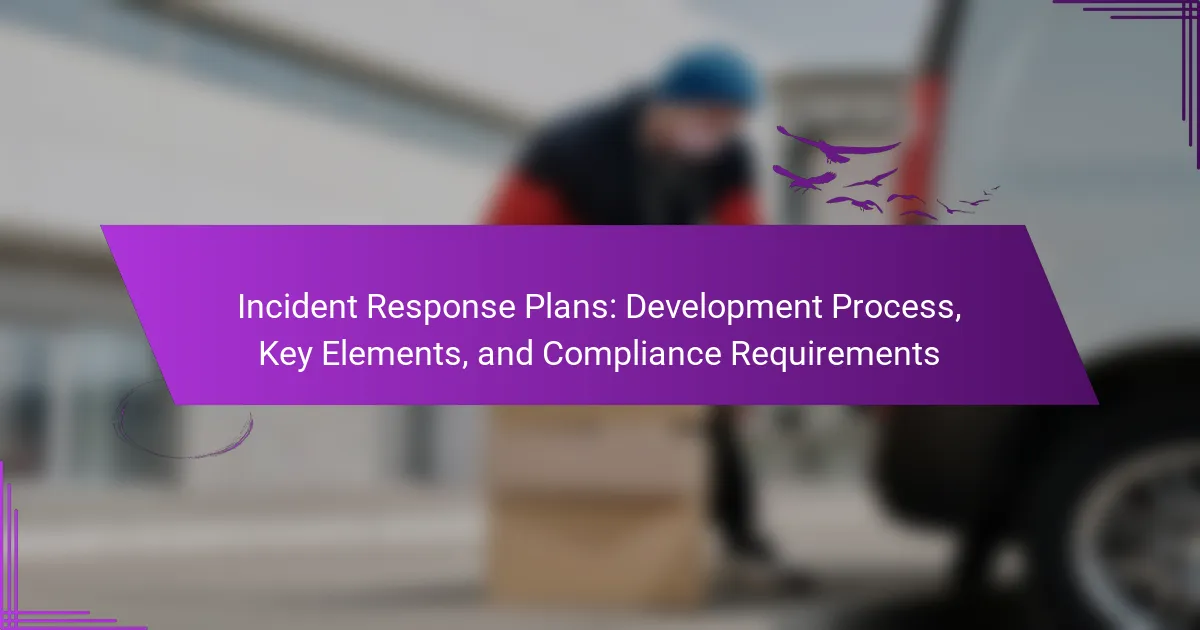
What is an Incident Response Plan?
An Incident Response Plan is a documented strategy for managing and responding to cybersecurity incidents. It outlines the procedures to follow when a security breach occurs. The plan includes roles and responsibilities for the response team. It also details communication protocols during an incident. Additionally, it specifies the tools and resources needed for effective response. An effective plan minimizes damage and recovery time. Organizations that implement such plans can reduce the impact of security incidents significantly. According to the National Institute of Standards and Technology (NIST), having an incident response plan is critical for organizational resilience.
How does an Incident Response Plan function?
An Incident Response Plan functions as a structured approach to addressing and managing security incidents. It outlines the procedures for detecting, responding to, and recovering from cybersecurity events. The plan typically includes roles and responsibilities for the incident response team. It also specifies communication protocols during an incident.
The plan is activated when a security incident occurs, guiding the organization in assessing the situation. It helps to contain the incident to minimize damage. The plan includes steps for eradicating the threat and recovering affected systems. Regular testing and updates of the plan ensure its effectiveness.
Evidence of its importance is seen in studies showing that organizations with an Incident Response Plan can reduce incident recovery time by up to 50%.
What are the key components of an Incident Response Plan?
The key components of an Incident Response Plan include preparation, detection, analysis, containment, eradication, recovery, and post-incident review. Preparation involves establishing policies and procedures for responding to incidents. Detection focuses on identifying and reporting incidents promptly. Analysis assesses the incident’s scope and impact. Containment aims to limit the damage from the incident. Eradication involves removing the cause of the incident. Recovery restores systems and services to normal operations. Post-incident review evaluates the response and identifies areas for improvement. These components ensure a structured and effective response to security incidents.
How do these components interact during an incident?
During an incident, the components of an incident response plan interact by coordinating actions and communication. The incident response team assesses the situation using predefined roles and responsibilities. Each member contributes their expertise to manage the incident effectively. Communication channels are established to ensure timely information sharing. Tools and technologies support data collection and analysis during the response. Stakeholders are informed to facilitate decision-making and resource allocation. The effectiveness of these interactions is critical for minimizing damage and restoring operations. Studies show that structured incident response plans improve organizational resilience and response times.
Why is an Incident Response Plan important?
An Incident Response Plan is important because it provides a structured approach to managing and mitigating security incidents. This plan helps organizations respond quickly and effectively to minimize damage. It outlines roles, responsibilities, and procedures for incident detection, analysis, and recovery. A well-defined plan reduces response time and enhances coordination among team members. According to a study by the Ponemon Institute, organizations with an incident response plan can reduce the average cost of a data breach by $1.23 million. Additionally, it ensures compliance with regulatory requirements, which can prevent legal penalties. Having an Incident Response Plan ultimately strengthens an organization’s overall security posture.
What risks does an Incident Response Plan mitigate?
An Incident Response Plan mitigates risks associated with data breaches, malware attacks, and system failures. It helps organizations respond effectively to security incidents. This reduces the potential for financial losses and reputational damage. According to a 2022 IBM report, organizations with an incident response plan can save an average of $2 million in breach costs. The plan also addresses compliance risks by ensuring adherence to regulations like GDPR and HIPAA. By having a structured response, organizations can minimize downtime and maintain business continuity. Overall, an effective Incident Response Plan is essential for risk management in cybersecurity.
How can an Incident Response Plan protect an organization?
An Incident Response Plan (IRP) protects an organization by providing a structured approach to managing cybersecurity incidents. It enables quick identification and containment of threats. This minimizes potential damage and reduces recovery time. An effective IRP outlines roles and responsibilities for team members. It also includes communication protocols for internal and external stakeholders. Regularly testing the IRP ensures its effectiveness and identifies areas for improvement. According to the Ponemon Institute, organizations with an IRP save an average of $1.23 million in breach costs. This demonstrates the financial benefits of having a well-defined plan.

What are the stages in the development process of an Incident Response Plan?
The stages in the development process of an Incident Response Plan are preparation, detection and analysis, containment, eradication, recovery, and post-incident review. Preparation involves establishing policies, procedures, and training for the response team. Detection and analysis focus on identifying and understanding the incident’s nature and scope. Containment aims to limit the impact of the incident. Eradication involves removing the cause of the incident. Recovery focuses on restoring systems and services to normal operations. Post-incident review assesses the response and identifies areas for improvement. These stages are essential for an effective and efficient incident response.
How do you assess risks in the development of an Incident Response Plan?
To assess risks in the development of an Incident Response Plan, identify potential threats and vulnerabilities. Conduct a risk assessment that includes evaluating the likelihood and impact of various incidents. Utilize tools such as threat modeling and vulnerability assessments to gather data. Engage stakeholders to understand their perspectives on potential risks. Analyze historical incident data to identify patterns and trends. Prioritize risks based on their severity and potential consequences. Document findings and create a risk register for ongoing monitoring. Regularly review and update the risk assessment in response to new threats or changes in the organization.
What tools are used for risk assessment?
Common tools used for risk assessment include risk matrices, qualitative analysis tools, and quantitative analysis software. Risk matrices visually represent the likelihood and impact of risks. Qualitative analysis tools facilitate subjective assessment of risks through expert judgment. Quantitative analysis software uses numerical data to calculate risk probabilities and impacts. Other tools include checklists, surveys, and software applications like Monte Carlo simulations. These tools help organizations systematically identify and evaluate risks. Their usage is supported by industry standards such as ISO 31000 for risk management.
How do you prioritize risks in the planning process?
To prioritize risks in the planning process, assess each risk’s likelihood and impact. Start by identifying potential risks that could affect the incident response plan. Evaluate the probability of each risk occurring, using historical data or expert judgment. Then, analyze the consequences of each risk on operations and compliance. Assign a score based on likelihood and impact to rank the risks. High likelihood and high impact risks should be addressed first. This method is supported by risk management frameworks, such as ISO 31000, which emphasize systematic risk assessment. Prioritizing risks effectively helps allocate resources efficiently and enhances incident response readiness.
What steps are involved in creating an effective Incident Response Plan?
Creating an effective Incident Response Plan involves several key steps. First, organizations must establish an incident response team. This team should include members from IT, security, legal, and communication departments. Next, they need to identify and categorize potential incidents. This categorization helps in understanding the risks and impacts associated with different types of incidents.
Following this, organizations should develop specific response procedures for each category of incident. These procedures guide the team on how to respond effectively and efficiently. Training the incident response team is crucial. Regular training ensures that team members are familiar with their roles and responsibilities during an incident.
Next, organizations need to conduct regular testing of the incident response plan. Testing helps identify weaknesses and areas for improvement. Finally, continuous monitoring and updating of the plan are essential. This ensures that the plan remains relevant and effective in the face of evolving threats.
How do you define roles and responsibilities in the plan?
Roles and responsibilities in the plan are defined by clearly outlining each team member’s specific tasks and duties. This involves identifying key roles such as incident commander, communication lead, and technical responders. Each role should have documented responsibilities to ensure accountability. For example, the incident commander oversees the entire response process. The communication lead manages internal and external messaging. Technical responders handle the technical aspects of the incident. This structured approach ensures that all aspects of the incident response are covered efficiently. Clear definitions help minimize confusion during an incident, leading to a more effective response.
What training is necessary for effective implementation?
Effective implementation of incident response plans requires specialized training in cybersecurity protocols. Personnel must understand threat detection and incident management procedures. Training should also cover risk assessment techniques and compliance with relevant regulations. Familiarity with communication strategies during incidents is essential. Regular simulations and tabletop exercises enhance practical skills. Knowledge of specific tools and technologies used in incident response is necessary. Continuous education on emerging threats and vulnerabilities is vital for ongoing effectiveness. This comprehensive training approach ensures preparedness and swift action during incidents.

What are the key elements of an Incident Response Plan?
The key elements of an Incident Response Plan include preparation, identification, containment, eradication, recovery, and lessons learned. Preparation involves establishing and training an incident response team. Identification focuses on detecting and confirming incidents. Containment aims to limit the impact of the incident. Eradication involves removing the cause of the incident. Recovery is about restoring systems and services to normal operation. Lessons learned include analyzing the incident to improve future responses. These elements are essential for an effective incident response strategy, ensuring organizations can respond to incidents efficiently and minimize damage.
What should be included in the communication plan of an Incident Response Plan?
A communication plan in an Incident Response Plan should include key components for effective information dissemination. It must outline the communication objectives during an incident. The plan should identify the stakeholders involved, including internal teams and external parties. It should specify communication channels to be used, such as email, phone, or secure messaging. The plan must detail the frequency of updates to stakeholders throughout the incident. It should include templates for messages to ensure consistent communication. The plan must designate a spokesperson responsible for public communication. Additionally, it should outline procedures for documenting communications for future review. These elements ensure clarity and efficiency in incident management.
How do you ensure clear communication during an incident?
Clear communication during an incident is ensured through established protocols and tools. First, a communication plan should be developed before an incident occurs. This plan outlines key messages, communication channels, and responsible parties. Regular training and drills help familiarize the team with these protocols. Utilizing multiple communication channels, such as emails, text messages, and conference calls, ensures message delivery. During an incident, timely updates should be provided to all stakeholders. Consistent messaging reduces confusion and misinformation. Documenting all communications aids in transparency and accountability. A study by the National Institute of Standards and Technology (NIST) emphasizes the importance of effective communication in incident response.
What channels are most effective for communication?
Email, phone calls, and instant messaging are the most effective channels for communication. Email provides a written record and allows for detailed information sharing. Phone calls enable real-time conversation and quick decision-making. Instant messaging offers immediate communication and is useful for quick updates. Studies show that organizations using multiple channels improve response times. Effective communication channels enhance collaboration during incident response.
How do compliance requirements influence an Incident Response Plan?
Compliance requirements shape an Incident Response Plan (IRP) by establishing mandatory protocols and procedures. These requirements ensure that organizations adhere to legal, regulatory, and industry standards. For instance, regulations like GDPR and HIPAA dictate specific response timelines and data protection measures. Non-compliance can result in significant penalties, thus motivating organizations to align their IRPs with these mandates. Furthermore, compliance requirements often dictate the documentation and reporting processes involved in incident management. This alignment enhances accountability and transparency during incident response. Ultimately, compliance frameworks guide the development of IRPs to mitigate risks and protect sensitive information effectively.
What regulations must be considered when developing an Incident Response Plan?
When developing an Incident Response Plan, several regulations must be considered. These include the Health Insurance Portability and Accountability Act (HIPAA), which mandates data protection for healthcare information. The General Data Protection Regulation (GDPR) governs data privacy for individuals in the European Union. The Federal Information Security Management Act (FISMA) requires federal agencies to secure information systems. The Payment Card Industry Data Security Standard (PCI DSS) sets security requirements for organizations handling credit card information. Additionally, the Sarbanes-Oxley Act (SOX) imposes regulations on financial reporting and data integrity. Compliance with these regulations is essential to ensure legal adherence and protect sensitive data.
How can organizations ensure compliance with these requirements?
Organizations can ensure compliance with incident response requirements by implementing comprehensive policies and procedures. They should regularly assess their current incident response plans against relevant regulations and standards. Organizations must provide training for employees to understand their roles during an incident. Regular drills and simulations help reinforce compliance and identify gaps in the response process. Additionally, organizations should maintain documentation of all incidents and responses for auditing purposes. Engaging with legal and compliance experts can ensure that all regulatory requirements are met. Regular updates to the incident response plan are necessary to reflect changes in regulations or organizational structure. These practices collectively help organizations maintain compliance with incident response requirements.
What best practices should be followed when creating an Incident Response Plan?
An effective Incident Response Plan (IRP) should include several best practices. First, it must define clear roles and responsibilities for all team members involved. This ensures accountability and efficient response during an incident. Second, the plan should include a detailed communication strategy. Timely and accurate communication is critical to manage stakeholders and mitigate damage.
Third, the IRP should incorporate regular training and simulations. This prepares the team for real-world incidents and helps identify gaps in the plan. Fourth, it should be regularly reviewed and updated. This ensures the plan remains relevant to evolving threats and organizational changes.
Fifth, the IRP must include a thorough documentation process. Accurate records of incidents and responses help in post-incident analysis and improvement. Lastly, the plan should align with compliance requirements and industry standards. This ensures that the organization meets legal and regulatory obligations. Following these best practices enhances the effectiveness of an Incident Response Plan.
How often should an Incident Response Plan be reviewed and updated?
An Incident Response Plan should be reviewed and updated at least annually. Regular reviews ensure the plan remains effective and relevant. Changes in technology, threats, or organizational structure may necessitate more frequent updates. Best practices recommend reviewing after any significant incident or breach. This approach aligns with guidelines from the National Institute of Standards and Technology (NIST). NIST emphasizes that timely updates are crucial for maintaining an effective response strategy. Regular assessments help identify gaps and improve response capabilities.
What common pitfalls should be avoided in the planning process?
Common pitfalls in the planning process include lack of stakeholder involvement. Engaging all relevant parties ensures comprehensive input and support. Another pitfall is insufficient risk assessment. A thorough analysis of potential threats is essential for effective planning. Additionally, neglecting to test the plan can lead to unpreparedness. Regular drills and simulations validate the plan’s effectiveness. Finally, failing to update the plan can render it obsolete. Incident response plans must evolve with changing threats and organizational structures.
Incident Response Plans (IRPs) are structured strategies for managing and responding to cybersecurity incidents, detailing roles, responsibilities, and communication protocols to minimize damage and recovery time. The article covers the development process of an IRP, including key components such as preparation, detection, containment, and post-incident review. It emphasizes the importance of compliance with regulations like GDPR and HIPAA, and outlines best practices for creating effective plans. Additionally, it highlights common pitfalls to avoid and the necessity of regular reviews and updates to ensure ongoing effectiveness in mitigating risks associated with security incidents.
